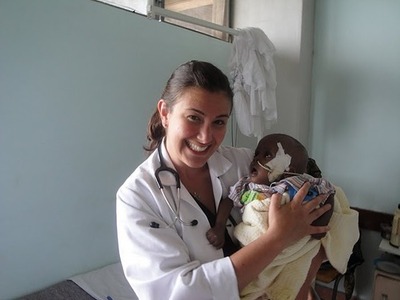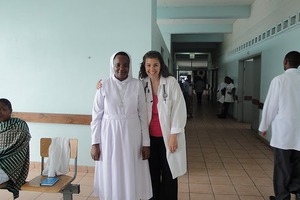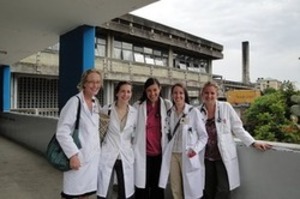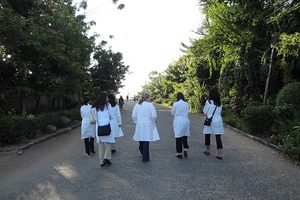Dr. Christina Gagliardo - Pediatrics at Weill Bugando
By Dr. Christina Gagliardo, now a pediatric infectious disease fellow at Children's Hospital of New York Presbyterian, Columbia University Medical Center

Dr. Gagliardo and a new friend at Weill Bugando
1/29/10 through 3/14/10, Weill Bugando Medical Center, Mwanza, Tanzania
Having done some work in developing countries before, I thought I would be well equipped for my time in Tanzania. As with any new experience in a foreign place, no amount of reading and inquiring could fully prepare me for the colorful sights, sounds, smells, culture, and practices until I was in the midst of it all. My first venture into the hospital was overwhelming to all the senses. I took in the sights of the women adorned in colorful kangas, often noticing two of them in one hospital bed, along with two children, because many times multiple patients shared one hospital bed. I heard an unfamiliar language, Swahili, echoing down the halls of the children’s ward. Soon I would learn the all-important greetings, and my attempts at the language would help me gain the trust of some of the patients and their parents. My sense of smell was immediately greeted by the pungent odor of so many people in a confined space in the sweltering heat, mixed with a formaldehyde smell which reminded me of my days in anatomy lab. During the physical examination of the patients, palpation of huge livers and spleens provided my sense of touch with physical findings I had not previously encountered. If one’s emotions could be considered a “sense,” I was in store for a huge range of feelings as I navigated my way through Bugando. These ranged from sadness, frustration, guilt, happiness, surprise, affection, and gratitude, depending on the situation I found myself in.
Admittedly, it took me some time to figure out my role at first. I started each day going to morning report, watching the intern on call report the statistics from the day before- the number of admissions, discharges, transfers, and deaths. I listened to an explanation of a death, which often involved the intern being informed after the patient had already “collapsed.” This would be followed by a case presentation from a medical student and an assistant medical officer (AMO) student. Often I had trouble following these presentations, partly because of the heavy accents, partly because morning report took place in a large, echo-filled corridor, and partly because the story was hard to follow at times. I made a note to myself to work on presentations with the students, doing a general review of the standard format to give a case presentation. I also had the chance to give morning report, and it was a nice opportunity to demonstrate what I thought was an organized case presentation. It was met with positive feedback, and I think provided a good example of a way to present a clear history and to formulate an appropriate assessment and plan.

Sister Violetta, an exceptional assistant medical officer student, and I on the children's floor
On the wards, I found myself rounding with a few specific residents that I formed a good working relationship with. I learned a great deal from these residents, from the various lines of treatment of malaria to how to approach a severely malnourished child. I saw so many interesting cases, and in instances where we were unsure what was going on, we were able to have a discussion about the patient and what the next steps should be. Borrowing from many pediatricians’ familiar adage that “not all that wheezes is asthma,” I tried to impart that “not all that have fever have malaria.” If a patient was not getting better on treatment for malaria, perhaps we should review the history and the exam, and consider an alternate (or additional, in many cases) diagnosis. My time on rounds was an invaluable way for me to gain insight into the diseases, treatments, and resources available, and to learn about the patients and physicians in the country.
I spent a lot of time working with the medical and AMO students. They had a great knowledge base, but less experience with physical exam skills and applying their knowledge to the patient bedside. An attending requested we focus on clinical skills, so I did in-depth reviews of various parts of the physical exam. We spent an afternoon in the labor ward teaching and practicing the newborn exam. After a lecture going over the complete neurologic exam, we spent time performing thorough neuro exams on patients. When I noticed that a particularly loud murmur was not picked up on initial examination of one child, we reviewed the cardiac exam and the basics of heart murmurs. Heart murmurs are abundant on the pediatric ward, so again, off we went to the bedsides of patients’ with known (and unknown) cardiac pathology.

Katrina (Cornell surgery), Naomi (Scottish medical student), Me, Meredith (Cornell neurology), and Lindsay (Cornell internal medicine)
I was often approached by the students with thoughtful questions and would prepare a simple discussion and meet with them in a group or individually to go over a topic. They ranged from simply asking what the difference between a premature and “normal” newborn infant is to how to distinguish between polio and Guillaine-Barre Syndrome. On many occasions I had to look information up, and this introduced me to another difference in our access to resources. I found myself combing the shelves for books in the hospital library to find a text where I could physically look up a topic. Preparing journal club was also interesting given the fact that Internet access was inconsistent, but you learn to be resourceful and creative! Every situation I encountered in the hospital provided an opportunity to learn and to come up with a plan in the context of what was available.
I felt especially connected to many patients and families that I formed relationships with. In particular, I found the “community” in the malnutrition room a welcoming and interesting crowd. Each day I would walk in and say “Habari,” and the room as a whole would reply in unison “Nzuri!” and on and on until I could not come up with any additional greetings in Swahili. This was always met by giggles from the mothers, and then they would begin approaching me with their children to look at some physical finding or ask a question with the help of an interpreter. When one of the patient’s clinical status deteriorated drastically, I was very proactive in getting him transferred to the ICU. It was here that I encountered frustration by what I felt was a lack of urgency in a serious situation. The patient was transferred, but there was no ventilator for him, and he ultimately passed away. Perhaps the other physicians knew this and that was the reason for what appeared to be inaction when a patient was critically ill and unstable. For me, I hold true to the fact that I took the same steps for the child that I would have had I been working on a pediatric floor in the U.S. with easy access to a variety of resources.
In addition to my experiences caring for children in the hospital, I visited local orphanages because I have a particular interest in adoption medicine. I was ecstatic to find that the people who ran these particular places were loving, altruistic individuals. The children who were lucky enough to be in these homes were well cared for and loved. Inevitably I was asked to look at various rashes and physical findings, and happily gave my recommendations. As I played with the children, the volunteers and hired Tanzania “mamas” told me some of their heart-wrenching stories and I was relieved that they landed in such a caring environment. I also visited the local street children’s home and was able to give my support to help send some of the kids to the Street Children’s World Cup in South Africa. I met a teenage boy with vertically transmitted HIV who had gone off of his antiretrovirals and had a CD4 count less than 100. I learned he shared a bed with another child who was being treated for active tuberculosis. The manager of the home devised a plan to bring the boy to the hospital to see patients with end stage AIDS, and he ultimately restarted his medications as a result of that visit.

On our way to the hospital... Day 1.
I was also able to enjoy some of the local sights, cuisine, and customs. I spent countless hours in various fabric stores, sorting through the brightly decorated kangas and kitenge fabrics to find the best one to make a dress. I navigated my way through the crowded, busy market, buying things from mangoes, to straw baskets, to various carved wooden pieces to bring back as gifts. One of the Tanzanian interns led us on a hike to the “Dancing Rocks” where we had a breathtaking, spectacular view of Lake Victoria and the land which we called “home” for the month. I tried ugali prepared by the wonderful cooks in our house, which is maize flour cooked into a dough-like consistency dipped in a sauce or stew. Teenage girls from the street children’s home taught me a traditional dance in a drum circle. Countless other experiences such as the ones I described made the trip a fantastic and memorable adventure.
Ultimately, I learned so much from my experience. As a pediatrician going into infectious disease, I saw an incredible amount of pathology and disease that I would not otherwise be exposed to. I can now describe the devastating effects of tetanus and polio to parents in my clinic that are reluctant to vaccinate their children. I have a better understanding of certain African traditions and practices as they relate to childcare and health. I will approach my families from different African countries with a great deal more insight as a result of my time at Bugando and in Tanzania. I can only hope to have given as much to the students, physicians, and patients I encountered.
Weill Cornell Medicine Center for Global Health 402 East 67th Street, 2nd Floor New York, NY 10065 Phone: (646) 962-8140 Fax: (646) 962-0285

